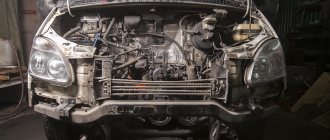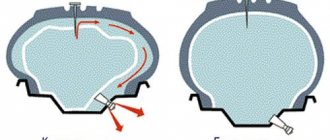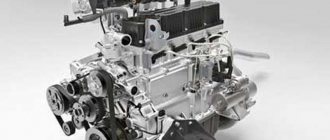What kind of work do we do?
Preliminary calculation of the cost of work. Our experts will advise you on the approximate cost of installing a contract Japanese engine in Gazelle, Gazelle Next, Ford Transit, Mercedes Sprinter, Volkswagen Crafter, Iveco Daily, etc.
Pre-sale preparation of units . By agreement with the client, we can replace consumables (oil seals, gaskets, rollers, filters in automatic transmissions).
Dismantling the original internal combustion engine and gearbox. We will carefully remove your old engine and gearbox, complete with wiring and all accessories, and give it to you. There will be no dismantling with a sledgehammer or grinder, so you can sell the original motor or install it again. We DO NOT TAKE removed units to count toward the cost of remodeling the vehicle!
Swap of a Japanese engine from Toyota. Direct installation of a Japanese engine and automatic transmission into your car and all necessary electrical work on a turnkey basis. We rework the driveshaft, install cruise control, and ensure full functionality of the instrument panel. Don't believe me? The evidence is HERE!
Electrical work. You can independently install a contract engine in your Ford, Mercedes, Crafter or Gazelle. And we will help you with connecting the engine and automatic transmission. We have, perhaps, the best auto electrician in the city, who has already eaten more than one Japanese dog in the matter of swapping engines from Toyota, converting Gazelles, connecting swap kits, and so on.
Other related work . We can pump up your tire, install power steering, charge your battery, or fix something.
see also
Comments 13
In order to legally rearrange the engine and not remove it when selling, we carefully study this site www.ptiafond.ru/
how to use the services of this organization is described in the bulletin board of this car www.drive2.ru/cars/gaz/24/24/sr62/, you can also ask its owner in a personal message.
By and large, from everything copied above, I can say. You can plug in the engine and ride it, because... The police do not check the license plates of the engine, because... it's just a spare part. Even when crossing the border of the Russian Federation, no one ever looked under the hood of my car (over the past 3 years, I crossed the border of the Russian Federation 8 times by car). The only thing is that when selling or re-registering, you need to plug the original engine back in, and then there will be no problems at all.
I recently dealt with the issue of replacing the engine, so I dug up so much information.
ALTHOUGH there have been cases when it was possible to register a collective farm installation, it is necessary to negotiate. That's why many racers pump up their own engines so that there is no hassle with registration.
I heard they put a 3.5 liter engine from a Kruzak into a Gazelle... it didn’t turn out too bad... there’s even a video on the net, but I just don’t remember where. I searched and didn't find it
1) Self-installation is not allowed; the fact that the installation was not carried out by hand is evidenced by documents from the service station:
- “Characteristics of the vehicle after making changes” - here the overall dimensions of the body, type, weight, number of seats are indicated, the parameters of the new engine are described - type, power, volume, they must match the old one, if not, then the manufacturer must indicate this engine as interchangeable in spare parts catalogue. If the engine is different, then you must have a certificate from the manufacturer stating that such a replacement is acceptable. - “Statement-declaration on the scope and quality of work to make changes to the design of the vehicle” - here it is indicated that the old engine was replaced with a new one, that they are interchangeable, that the fastenings are identical, that no violations were found in the operation of the new engine, the operation is stable. - a copy of the “work order” or “act of work order” - it states what was done and how much it cost (it cost me 7,767 rubles) - a copy of the “certificate of conformity” - indicating that the service station has the right to carry out such work. — receipt for payment of work with a check — I didn’t need it
2) With these documents and the “Certificate for the released license plate” we go to the traffic police: - We write a statement that it is necessary to make changes to the title. It will be necessary to decide on the old engine, if it is not needed, then indicate what to “dispose of,” if it is needed, then you will have to bring it with you and show it at the reconciliation and receive a “certificate for the released power unit.” — We pay a state fee of 500 rubles. — We are checking the numbers. — We hand over all the documents, and later we pick up new ones (as when applying for registration).
3) We are going home as the happy owner of a new “heart” - a note “an engine is installed...” will appear in the PTS, a new registration certificate will be given, a “certificate for the released power unit” and the “deed of sale” will not be returned.
- No more than 5 working days should pass from the moment of replacement - Have all the documents with you just in case - The service station does not have the right to carry out work without making sure that you have a “certificate for the released power unit” - “Certificate invoice” is only needed legal entities, but for us, a “deed of sale and purchase”, handwritten and certified by the seller and buyer, is enough.
Decree of the Government of the Russian Federation of October 15, 1999 N 1165 “On the sale of released military property” (Collected Legislation of the Russian Federation, 1999, N 43, Art. 5213).
5.1. Registration of vehicles, numbered units, deregistered by the State Traffic Inspectorate, purchased on the basis of an agreement concluded in simple written form, signed by the parties to the transaction, and also certified by a seal, if the presence of a seal for the parties to the transaction is provided for by the legislation of the Russian Federation, is carried out upon submission of the agreement, application (Appendices No. 1 and No. 2) and a vehicle passport or a document for a numbered unit, as well as other documents provided for by these Rules. (clause 5.1 as amended by Order of the Ministry of Internal Affairs of the Russian Federation dated January 19, 2005 N 26)
5.2. Registration of vehicles deregistered by the State Traffic Inspectorate, numbered units purchased on the basis of an agreement concluded orally, is carried out upon submission of an application and a vehicle passport or a document for a numbered unit, as well as other documents provided for by these Rules. (clause 5.2 as amended by Order of the Ministry of Internal Affairs of the Russian Federation dated January 19, 2005 N 26)
5.3. When the registration data is changed, the ownership of numbered units acquired in the manner prescribed by paragraphs 5.1, 5.2 of these Rules is confirmed by documents (certificates) issued by the registration departments for the released numbered units, or other documents certifying the ownership of the numbered units.
5.4. Registration of vehicles owned by individuals registered as individual entrepreneurs is carried out in the manner prescribed by these Rules for registering vehicles for individuals. Registration of vehicles belonging to peasant (farm) farms operating without forming a legal entity is carried out by the heads of these farms.
GAZ Gazelle 2006, l. With. - with your own hands
Tyumen
GAZ 3102 Volga, 2007
120 000 ₽
Ust-Ordynsky
GAZ 31105 Volga, 2006
90 000 ₽
Omsk
GAZ 21 Volga, 1964
30 000 ₽
Aksenovo-Zilovskoye
GAZ 3110 Volga, 2000
55 000 ₽
See more cars on Drome
Participate in the discussion can only registered users.
Login Register
This is interesting: Do-it-yourself installation of gas equipment: 2, 3 and 4 generations
GAZ engine
The Russian Steer appeared at the Gorky Automobile Plant in 1998, when an Austrian company sold a license to the Russians. According to tests, the Austrian engine turned out to be the best among all diesel engines:
Used GAZ 560 engine ready for installation
- Was undemanding to fuel;
- Started well in sub-zero temperatures;
- Had good dynamics and high efficiency;
- I used diesel fuel sparingly.
The first copies of engines were assembled by Gorky residents mainly from imported parts, so the quality was excellent. It was planned to produce 250 thousand copies per year, taking into account that the products would be supplied to other Russian enterprises.
The main difference between the GAZ 560 internal combustion engine is its monoblock design. The block and cylinder head were inseparable from each other and formed a single whole. Advantages of this design:
- there is no head gasket, and replacement is not required if it overheats;
- coolant does not get into the oil because the gasket does not burn out;
- the block head cannot come loose since it is a monolithic part of the block.
The process of engine repair for Gazelle
It should be noted that in theory everything is always better than in practice, and prototypes are not an indicator. Subsequently, many problems arose with the Russian “Steyer”, and purely Russian factors were to blame. The quality of the fuel sometimes turned out to be such that even the most adapted Russian diesel engine could not withstand it. And after parts for the motor began to be manufactured in Russia, motors began to fail much more often.











